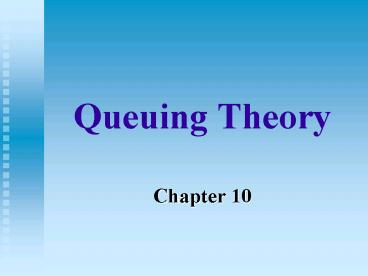Queuing Theory - PowerPoint PPT Presentation
1 / 22
Title:
Queuing Theory
Description:
We have to have more servers or shorter service times. So ... FAX (or copier) Example. Employees arrive at a rate of 20 per hour. Assume a Poisson Distribution ... – PowerPoint PPT presentation
Number of Views:167
Avg rating:3.0/5.0
Title: Queuing Theory
1
Queuing Theory
- Chapter 10
2
Why Study Queues?
- Standing in Line Costs
- We loose customers
- We waste employee time
- We bottleneck production processes
- Eliminating Lines Costs
- We have to have more servers or shorter service
times - So whats the best trade-off?
3
Components of Queuing Process
- Arrivals (Random)
- Servers (Random)
- Waiting Lines or Queues
- Discipline First Come, First Served (FCFS),
LCFS, etc.
4
Basic Structures
- Channel ServersPhase Steps in Service
- Single Channel, Single Phase
- Multiple Channel, Single Phase
- Single Channel, Multiple Phase
- Multiple Channel, Multiple Phase
- Other
5
Costs of a Queue
Total Cost
cost
Service Costs
Waiting Costs
Level of Service
6
Operating Characteristics
- Probability of the Service being idle
- No units in the system P0
- Probability of some specified number of customers
(units) are in the system - Pn
- Mean (expected) waiting time for each customer (W
for total or Wq in queue)
7
- Mean (expected) number in the system
- L
- Mean (expected) number in the queue
- Lq
8
Model Assumptions
- Arrival Distribution
- Most Commonly a Poisson Distribution
- Discrete Distribution (See page 474)
Where r Number of arrivals P(r) Probability
of r arrivals l Mean arrival rate e 2.71828
(base of natural log) r! r factoral ( r )
(r-1)(r-2)(r-3)..
P(r) e - l (l)r r!
9
Mean Time Between Arrives(More Assumptions)
- Negative exponential distribution with mean of 1
/ l - Example If mean arrival rate is 2 per hour then
the mean time between arrivals is 1 / l or 1 / 2
hours or 30 minutes
10
Distribution of Service Times(More Assumptions)
- Most commonly negative exponential probability
density function - Area under the curve (See page 475)
When t Service Times f(t) probability
density function t m mean service rate 1 / m
mean service time e 2.71828 (base of natural
log)
f(t) m e -m t
11
Other Issues
- Infinite vs. Finite Calling Population
- Infinite vs. Finite Queue Length
- Steady State vs. Transient System
- Arrival Rate vs. Service Rate
- Ratio of l / m will be less then one or the
queue expands uncontrollably - Exponential relationship (see page 478)
12
Queuing Notation
- Written(a/b/c) (d/e/f)
- a arrival dist
- b service dist
- c of servers
- d queue discipline
- e max in queue
- f size of calling pop
- Distributions
- M Poisson
- D Deterministic
- Ek Erlang
- G General
- Example
- (M/M/1) (FCFS/inf/inf)
13
Single-Channel, Single-Phase(M/M/1) Formulas
- Probability of no units in the systemPo 1 - l
/ m - Probability of n units in the systemPn (l /m)n
(1 - l /m) - Mean of units in systemL l / (m - l)
- Mean of units in the queueLq l 2 / m ( m - l
)
14
(M/M/1) Formulas (Cont)
- Mean time in the systemW 1 / ( m - l )
- Mean time in the queueWq l / m ( m - l )
- Service Facility Utilizationp l / m
- Service Facility Idle TimeI 1 - l /m
15
FAX (or copier) Example
- Employees arrive at a rate of 20 per hour
- Assume a Poisson Distribution
- Average time at machine is 2 minutes
- Assume a Negative Exponential Dist.
- 1/ m
- One Machine with One Line(M/M/1) (FCFS/inf/inf)
System
16
- Mean of units in systemL l / (m - l)L 20
/ (30 - 20)L 20 / 10L 2 employees in system
17
- Mean of units in the queueLq l 2 / m ( m - l
)Lq 20 2 / 30 ( 30 - 20 )Lq 400 / 30 ( 10
)Lq 400 / 300Lq 1.33 employees in line
18
- Mean time in the systemW 1 / ( m - l )W 1 /
( 30 - 20 )W 1 / 10 of an hour or W 6
minutes each (on average) waiting for
and using the machine
19
- Mean time in the queueWq l / m ( m - l )Wq
20 / 30 ( 30 - 20 )Wq 20 / 30 ( 10 )Wq 20
/ 300Wq 1 / 15th of an hour orWq 4
minutes each (on average) just
waiting in line
20
- Service Facility Utilizationp l / mp 20 /
30p .67 or 67 or the time - Service Facility Idle TimeI 1 - l /mI 1 -
20 / 30I 1 - .67I .33 or 33 of the
time its idle
21
Should we hire an operator?
- An operator would reduce average service from 2
minutes to 1.5 minutes - The operator would cost 8.00 / hour
- Average employee wage is 10.20 hours
- L l / m - l 20 / (40 -20) 1 in system
- The average number of employees in system is
reduced from 2 to 1
22
Resulting Costs
- Alternative Service Waiting Total
Annual Cost Cost
Cost Cost No Oper. 0
20.40 20.40 40,800
2 10.20 With Oper.
8 10.20 18.20 36,400
Annual Savings
4,400

